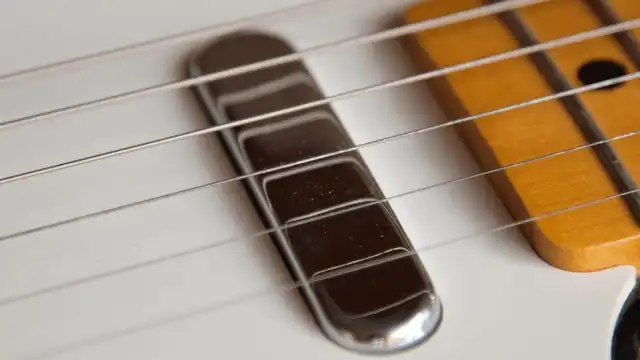What you'll need
Obviously, you'll need
new guitar strings. Besides this, you'll want to have some wire cutters and a towel nearby. Other items that make life easier are a peg winder and a neck cradle, though these are optional. Have your tuner on hand as well. If you can, work on a table, not on your lap sitting on the sofa. Lay your guitar out on its back and make sure that you have enough room to work with before you begin.
How To Change Guitar Strings, Step-by-Step:
1. Unwind the string
Starting with the high E-string, loosen the tuning peg with the peg winder. You won't need to unwind the string completely, just enough so that you can manually unwind the string from the peg. This will save wear on your tuning key mechanism. Remove the string from the peg, then from the bridge and toss it in the trash (it's usually easiest to coil the string once or twice around itself first, so it won't pop out of the garbage can).
2. String up the new string
String the new E-string into the bridge and pull it over towards the nut, then thread it through the tuning post. At first you’ll want to hold the string above the nut, then pull at the center of the string until there’s about six inches between the string and the fret board. That’s just enough slack for winding. If you leave more slack, you'll spend days winding up; less slack and you'll experience tuning instability for the life of the string.
3. Wind to tension and tune
Once you've left enough slack, you can begin to wind the string. Make sure you are winding from the top of the peg to the bottom, with a steady speed, not catching the extra string that's left over. Also, watch that the string is winding on the side of the peg closest to the center of your headstock.
Once you've wound up to tension, tune the string a bit to keep the torsion on the neck the same as it was before the string was removed. Bend the excess string behind the tuning peg back out of the way.
Repeat this same process with each string until complete.
4. Stretch out your strings
Anyone who has restrung their own guitar has experienced the brutal two or three days of re-tuning the strings every few minutes. Seems like the guitar just won't keep a tune. This is because the strings will slowly stretch a bit until they reach their peak torsion. You can get around this constant tuning by stretching the strings right now.
Lay a folded towel over the bridge and hold it down. Take the low E-string and pinch it near the bridge and begin pulling it up, moving up the string towards the nut. You don’t want to pull too much, just enough that you feel the string begin to stretch. Do this with each of the strings. (The towel is optional).
Now you can push down gently on the short lengths of string between the nut and the pegs, again, pre-stretching the string. This entire process of pre-stretching won’t eliminate the need to re-tune entirely, but it will help your strings adjust to the tune a lot quicker.
5. Clip those hanging ends
Besides looking a bit sloppy, those ends hanging off the tuning pegs are sharp and pointy and will prick you when you least expect it. Be neat and trim those ends to about a quarter to an eighth of an inch from the peg. If you really don't want to get pricked in the future, you can always push the ends down so they are not sticking out, but that's optional.
Tune up one more time and you're all set! As with many things, the simplest way is the best way how to change guitar strings.
To get the most life out of your strings, always play your guitar with clean hands, and wipe your strings off with a cloth before you put it up. You'd be surprised how far just a little bit of care will take you in this regard.
______________
We know we're biased in saying this, but we have some of the
best acoustic guitar strings you'll find. As long as you're changing strings out, why not try one of our specially design and handwound sets, made here in Music City USA (Nashville, y'all).
And if you're looking for more great ideas on how to push your playing farther, read our posts on
alternate guitar tunings and the thickness of
guitar picks (an inexpensive and dramatic way to change your playing style and tone).
Happy Playing!









